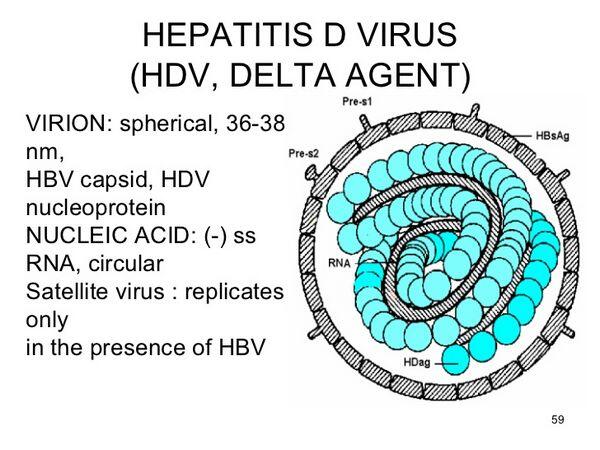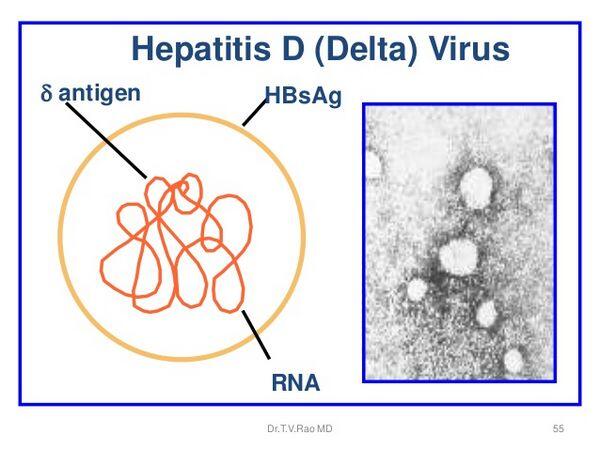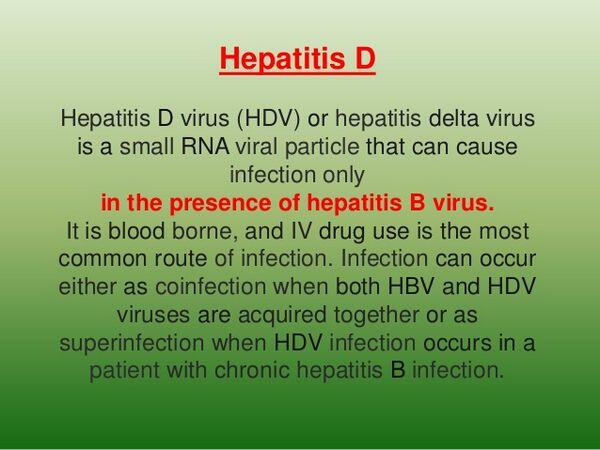Essentials of Diagnosis
- Occurs only in patients with preexisting or concurrent hepatitis B.
- Occurs in the same groups at risk for hepatitis B.
- May be associated with fulminant hepatitis or rapid progression of chronic hepatitis B.
- Diagnosed by presence of IgM antibody to hepatitis D antigen or by IgG seroconversion to this antigen.

General Considerations
Epidemiology
Delta hepatitis is spread just as hepatitis B and is most prevalent in groups at high risk of hepatitis B infection. Injection drug users are those at greatest risk in the western world, and ~ 50% of such individuals may have IgG antibody to the delta virus antigen. Delta virus infection is rare in the U.S., northern Europe, and Japan but largely prevalent in southern Europe, Africa, and South America. Because blood is not yet routinely screened for the delta agent, blood products and dialysis transmission are possible sources for those who have prior hepatitis B. Nonparenteral and vertical transmission can also occur.
Microbiology
Delta hepatitis is caused by the hepatitis D virus. This small single-stranded RNA virus requires the presence of hepatitis B to provide its protein shell and is thus found only in persons with acute or chronic hepatitis B infection.
Pathogenesis
The method of replication of hepatitis D viral RNA is not clear. Associated with the RNA are proteins of 27 and 29 kDa that constitute the delta antigen. This protein-RNA complex is surrounded by HBsAg. Thus, although the delta virus produces its own antigens, it utilizes HBsAg in assembling its coat.
Clinical Findings
Signs and Symptoms
Two major types of delta infection have been noted.
- Simultaneous delta and hepatitis B infection: This infection is clinically identical to acute hepatitis A or B, except for a higher rate of fatal hepatic necrosis than is seen with hepatitis B alone.
- Delta superinfection in those with chronic hepatitis B: This infection increases the severity and progression of chronic hepatitis B. Death due to liver disease may occur in 20% of superinfected patients.
Laboratory Findings
Similar to hepatitis A and B
Imaging
Similar to hepatitis A and B

Differential Diagnosis
Simultaneous infection with both delta and hepatitis B results in clinical hepatitis that is indistinguishable from acute hepatitis A or B; however, fulminant hepatitis is much more common than with hepatitis B virus alone.

Complications
Persons with chronic hepatitis B who acquire infection with hepatitis D suffer relapses of jaundice and have a high likelihood of developing chronic cirrhosis. Rapidly progressive liver disease and death may occur in = 20% of doubly infected persons.
Diagnosis
Diagnosis of hepatitis D is made by demonstrating IgM or IgG antibodies, or both, to the delta antigen in serum. IgM antibodies appear within 3 weeks of infection and persist for several weeks. IgG antibodies persist for years.
Treatment
Response to interferon alpha treatment is less than in patients who have only hepatitis B. Recommended doses are higher (5-10 million U daily).
Prognosis
Superinfection with hepatitis D worsens the prognosis of preexisting hepatitis B, increasing the rate and rapidity of developing cirrhosis.
Prevention & Control
Because the capsid of delta hepatitis is HbsAg and hepatitis D depends on hepatitis B for its replication, measures aimed at limiting the transmission of hepatitis B, for example, through vaccination, prevent the transmission of delta hepatitis.

